
Sedimentation Practices
P.T. Weiss, A.J. Erickson, J.S. Gulliver, R.M. Hozalski
Process
Sedimentation is the process by which solids are removed from the water column by settling. Sedimentation practices (e.g., dry ponds, wet ponds, wet vaults, and other devices) consist of engineered surface basins or underground vessels that decrease the flow velocity and/or the mixing and provide temporary storage of stormwater runoff to allow suspended solids to settle and be retained by the stormwater treatment practice. Pollutants that are integrated into or sorbed onto the settled solids will also be retained. The retained solids must be periodically removed from the sedimentation practice to maintain effective solids removal performance. This section includes discussion on dry ponds, wet ponds, wet vaults, and other commercial devices. Sedimentation practices in which solids retention is enhanced by vegetation are discussed in Biologically Enhanced Practices.
Solid settling in stormwater applications can be described by Stokes’ Law, given in equation 10.1 (Stokes 1851). Stokes' Law is applicable to clay, silt, and fine sand in stormwater, and can be applied up to fine sand (Reynold’s Number, Re = Vd/ν < 10) with a maximum error in settling velocity of 25%.
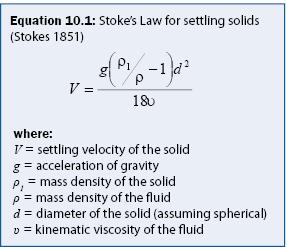
The settling velocity of solids in a fluid is dependent on the size and density of the solids and the properties of the fluid (i.e., density and viscosity) in which the solids are entrained. The size of silica-based particles is given in table 10.1. For stormwater applications, the fluid in which solids are immersed is assumed to be water, for which density is nearly constant and viscosity varies only with temperature. The dependency of settling velocity on sediment size and density as well as water temperature is shown in figure 10.1. Using Stokes' Law, the settling velocity of solids in water at 0 °C (32 °F) is approximately 43% of settling velocity of the same solids in water at 40 °C (90 °F).
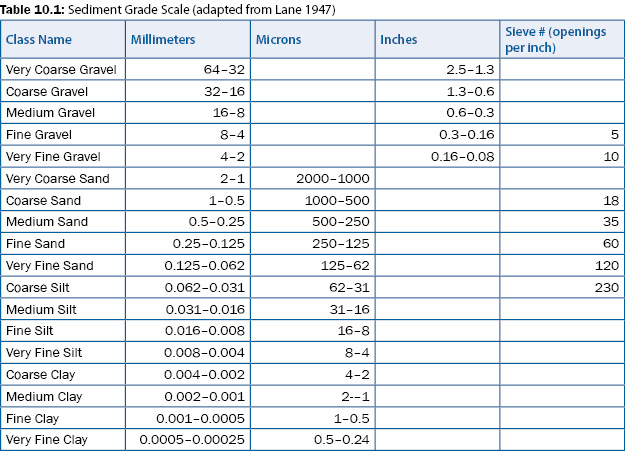
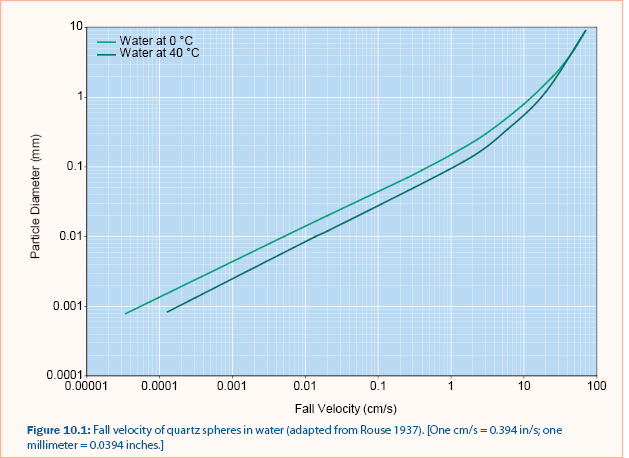
A relationship for settling velocity that incorporates larger particles, such as sands with Re > 10, has been developed by Ferguson and Church (2004) as shown in equation 10.2. Equation 10.2 becomes Stokes' Law at small particle diameters and results in a constant drag coefficient for large particle diameters.
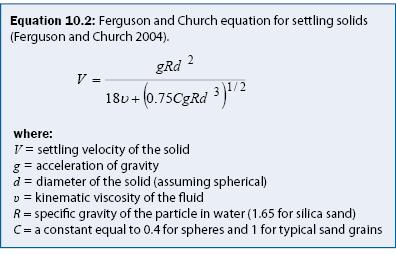
It is evident from equations 10.1 and 10.2 that larger solids will settle faster than smaller solids of the same density. It is also apparent that solids with a relatively large density will settle more quickly than less dense solids of the same size. Thus more solids of varying sizes and densities will settle out of water when more time (i.e., residence time) is allowed. Sedimentation practices can be designed to optimize settling; design guidelines for sedimentation practices are provided in the Minnesota Stormwater Manual. The performance of the sedimentation practice is very dependent on the settling velocities of the suspended solids. Furthermore, the settling velocities of solids in runoff, or a corresponding particle size distribution which enables settling velocities to be estimated, are often assumed even though particle size distributions can vary widely by watershed, rainfall intensities, and time since last rainfall, among other factors. An incorrect assumption regarding particle size distributions or settling velocities will result in either a sedimentation practice being under-designed and not meeting watershed goals, or being over-designed which may result in unnecessarily large construction and operating and maintenance costs. For a detailed discussion and demonstration of the importance of particle size distributions on the performance of sedimentation practices see Particle Size Distribution.
Practices
Dry ponds
Dry ponds are unlined depressions in the ground surface fitted with inlets and outlets to manage the collection and release of stormwater. Dry ponds are also called dry detention ponds or detention basins. Dry ponds (figure 10.2) temporarily store stormwater runoff and release the water through a designed outlet structure at a slower rate than if the dry pond were not present. Infiltration and evapotranspiration may occur, but these processes are usually not the primary modes of water transport out of the pond. Dry ponds are designed to drain completely and therefore should not maintain a pool of water between runoff events. Dry ponds also remove suspended solids from stormwater via sedimentation, which is the primary mechanism for pollutant retention in dry ponds.
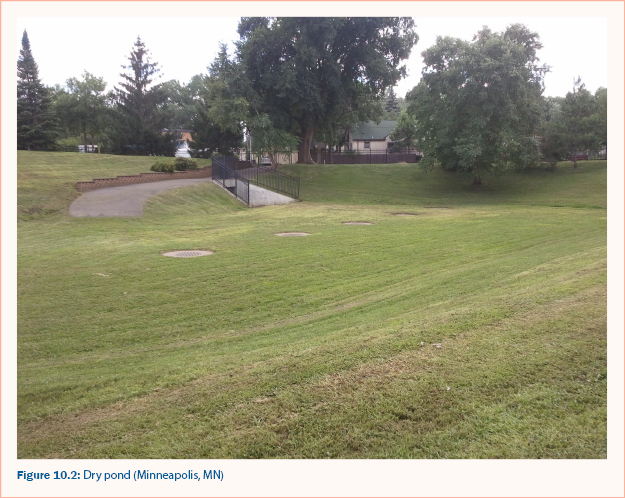
The prescribed surface area for a dry pond is typically 0.5% to 2.0% of the total watershed area (Urban Drainage Flood Control District 1992). Historically, the primary function of dry ponds has been to reduce the peak runoff flow rate and reduce the risk of flooding downstream due to urbanization of the upstream watershed. More recently, the pollutant-retention mechanisms that occur within dry ponds have been investigated. Weiss et al. (2007) reported that on average (± 67% confidence interval), dry ponds in the United States retain 53% (± 28%) of total suspended solids and 25% (± 15%) of total phosphorus. The U.S. EPA (1999) reported typical ranges of 30%–65% for total suspended solids and 15%–45% for total phosphorus in dry ponds.
Wet ponds
Wet ponds are depressions in the ground with elevated outlet structures that allow water to pond and be stored between runoff events. Stormwater runoff remains in a wet pond because the outlet structure is at a greater elevation than the pond bottom. Although infiltration is sometimes possible, some wet ponds do not infiltrate stormwater because they have an impermeable liner or because the groundwater table is too high for the water to infiltrate directly into the soil. Wet ponds (figure 10.3) store runoff temporarily and release the water through a designed outlet structure elevated above the pond bottom at a slower rate than if the wet pond were not present. The elevated outlet structure allows a pool of water to remain within the wet pond until the next runoff event displaces it or until all the water below the outlet structure infiltrates and/or is removed via evapotranspiration. The purpose of storing water in a wet pond is to allow time for solids to settle out of the water column. Wet ponds are typically designed with a surface area of 2% to 3% of the impervious watershed area (U.S. EPA. 1999) and are sometimes called retention ponds or wet basins.
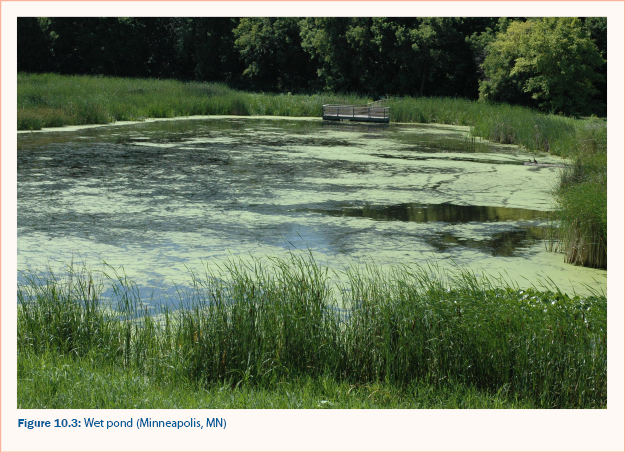
On average (±67% confidence interval), wet ponds in the United States retain 65% (±32%) of total suspended solids and 52% (±23%) of total phosphorus (Weiss et al. 2007). The U.S. EPA (1999) reported typical ranges of 50% to 80% for total suspended solids and 15% to 45% for total phosphorus in wet ponds.
Underground sedimentation devices
Underground sedimentation devices treat stormwater without the need for land surface area and, therefore, are often used in urban areas where land area is limited and/or cost-prohibitive. Prefabricated underground sedimentation devices, sometimes called hydrodynamic separators or proprietary devices, are available from many manufacturers. Many of these devices store little, if any, stormwater and therefore capture pollutants from the stormwater, but do not reduce peak flows significantly.
Wet vaults are underground vessels used to temporarily store and treat stormwater runoff. A common wet vault design consists of large diameter corrugated metal pipes placed underneath a parking lot. Parking lot and rooftop runoff is routed into the underground pipes for temporary storage and subsequent release to the storm sewer. Some wet vaults are designed with perforations, which, given the proper underground conditions, can slowly release water into the surrounding soil. A typical wet vault is shown in figure 10.4.
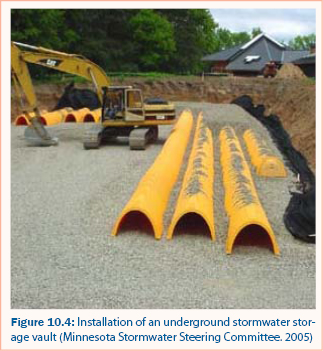
Frequency of use
A survey (Erickson et al. 2009) designed to collect information related to stormwater treatment practice use in Minnesota and Wisconsin revealed that dry ponds and wet ponds are some of the most common stormwater treatment practices in use throughout the state. Over 80% of responding municipalities manage at least one dry pond while over 95% manage at least one wet pond. Detailed survey results on the use of sedimentation practices are presented in table 10.2.
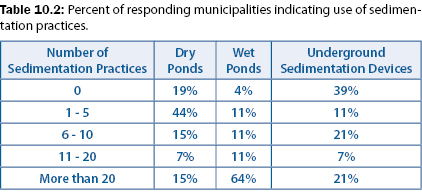
Assessment
Sedimentation practices are designed to retain solids by settling, but other pollutants (e.g., phosphorus, hydrocarbons, and metals) attached to retained solids (by adsorption, etc.) are also retained by sedimentation practices. Therefore, a topic of concern for sedimentation practices is the analysis of pollutants that may be sorbed to (and subsequently desorbed from) retained solids. Measuring and comparing the solid-bound pollutant concentrations at the influent and in the retained solids, or the dissolved pollutant concentrations at the influent and effluent, may give insight into processes occurring within the device, such as sorption or desorption of pollutants.
Sedimentation practices can be evaluated by all four levels of assessment: Visual Inspection, Capacity Testing, Synthetic Runoff Testing, and Monitoring. Discussion and recommendations for applying each of these methods to sedimentation practices can be found by clicking on the preceding links, or the drop-down items under Sedimentation Practices on the main menu.
Continue to Visual Inspection.